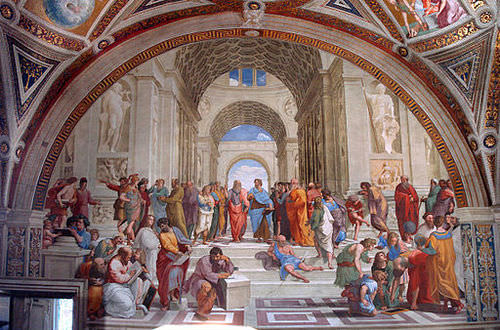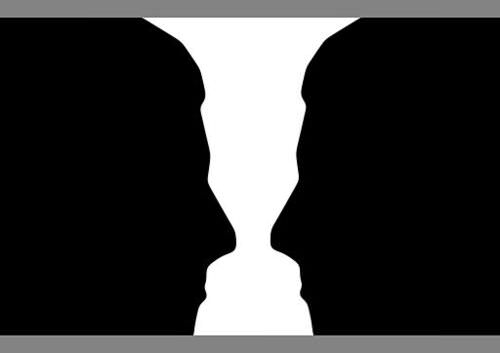2.4 排
Section outline
-
Plato’s Theory of the Ideal Forms
::Plato 的理想形式理论Plato describes the death of Socrates in the dialogue, the P haedo . In that dialogue Plato becomes the first human to set into written form an attempt to prove that human beings have souls which are spiritual and immortal. Many cultures have such a belief. It can be found all around the world. However, the Greeks were the first to attempt to offer a proof for its existence and a proof based upon reasoning. In order to understand the P haedo and its arguments one must first be aware of Plato’s Theory of the Forms. Plato makes use of them in attempting to prove that the soul exists and that it survives the death of the body.
::柏拉图描述了苏格拉底在对话中死亡的情况,Phaedo人。在该对话中,柏拉图人成为第一个试图以书面形式证明人类有精神和不朽的灵魂的人。许多文化都有这样的信仰。它可以在世界各地找到。然而,希腊人首先试图提供其存在的证据和根据推理提供的证据。为了理解Phaedo及其论点,人们必须首先了解柏拉图的《形式理论》。柏拉图利用他们来试图证明灵魂的存在和它生存在身体死亡之后。In the P haedo Plato uses the Theory of the Forms. Aristotle made it clear that Socrates did not use that theory, it was developed later by Plato. So what is most likely is that Plato probably began the dialogue right after the death of Socrates. He must have taken notes. He was not present at the death; he was ill. He probably recorded what others told him occurred and then years later returned to the notes and finished the dialogue. So the P haedo is a mix of what Socrates actually said and words Plato placed into the mouth of Socrates to complete the arguments and offer stronger ones consistent with Plato’s views. It is likely a dialogue from Plato’s middle period of creativity (see mini-lecture on Plato’s Dialogues). The dialogue contains four different arguments to prove the existence of the soul. Socrates states at the conclusion of the first that it is sufficient. The other three were probably added later by Plato and utilize references to Plato’s theory of the forms.
::Phaedo Plato在Phaedo Plato使用了形式理论。 亚里士多德清楚地表明Socrates没有使用这一理论,而是由Plato后来开发的。 因此,最有可能的是,Plato可能在Socrates死后立即开始对话。 他必须注意到。 他没有在场,他病倒了。 他可能记录了其他人告诉他发生的事情,几年后又回到笔记,并完成了对话。 因此,Phaedo是Socrates实际说的话和Plato的文字混杂在一起,放在Socrates的口中,以完成辩论,提供与Plato观点一致的更强有力的理论。 很可能是来自Plato的中间创造性时期的对话(见Plato对话的微型演讲 ) 。 对话包含四个不同的论点来证明灵魂的存在。 Socrates在第一个结束的时候就表示它已经足够了。 另外三个词可能后来被Plato添加,并引用了Plato的表格理论。The Theory of the Forms
::形式理论理论For many years I presented this theory in class utilizing a series of questions and practical demonstrations. In this medium we shall attempt to get as close as possible to that. We start off with a simple question:
::多年来,我利用一系列问题和实际示范,在课堂上提出了这一理论。在这个媒介中,我们将尽量接近这个理论。我们首先提出一个简单的问题:What is this a picture of?
::这是什么照片?You probably answered that it is a chair. And you are correct! Now answer this question: What is a chair?
::你可能回答说这是一张椅子。你是对的!现在回答这个问题:什么是一张椅子?You may have answered “ It is something that you sit on” Over the years everyone who volunteers the answer in class has said that. It seems so obvious! A chair is something that you sit on. Now look at this photo and consider that answer.
::你可能回答过“这是你坐着的东西”。 多年来,所有在课堂上自愿提出答案的人都这么说。这似乎太明显了!椅子就是你坐着的东西。现在看看这张照片,想想这个答案。Arguments for the Existence of the Soul
::灵魂存在的理由Now just because someone sits on a desk it doesn’t mean it is a chair but a chair can’t be just something that you sit on. You can sit on many things; desks, stairs, large rocks, benches, tree stumps, cars, your little brother or sister, etc….
::因为有人坐在桌子上, 这并不意味着它是一张椅子, 但椅子不能只是你坐在椅子上的东西。 你可以坐在很多东西上:桌子、楼梯、大块石头、椅子、树桩、汽车、你的弟弟或妹妹等等。What is a chair?
::什么是椅子?By now you should realize that the original simple answer, “Something that you sit on” , is wrong or at least not really correct. We can do better than that. You may now be thinking that a chair is something that was made to have people sit on it. Further to prevent a human or other animal from being a chair you should also realize that whatever a chair is--it is non-living matter. It is inanimate. In a classroom someone or other, by now, is offering the following as the definition of a chair: A chair is an inanimate object made for the purpose of having humans sit on it. Better yet: A chair is an inanimate object expressly designed and manufactured for the purpose of having humans sit upon it.
::现在,你应该意识到,最初的简单答案,即“你坐的东西”是错误的,或者至少是不完全正确。我们可以做得更好。你现在可能认为,椅子是用来让人坐在椅子上的东西。此外,为了防止人类或其他动物成为椅子,你也应该意识到,不管椅子是非生物物质,它是无生命物质。在教室里,现在有人或其他人提供以下的椅子定义:椅子是用来让人类坐在椅子上的非生物物质。更好的是:椅子是专门为让人类坐在椅子上而设计和制造的无生命物质。Now if you agree with that definition being much better than “Something that you sit on” We are off to a good start in attempting to understand Plato’s Theory of the forms.
::现在,如果你同意这个定义比“你所坐的某件事情”要好得多的话,我们将在试图理解柏拉图对形式的理论方面有一个良好的开端。A chair is an object that humans can sit on, we can also stand on them to get your picture taken! .
::人可以坐在椅子上, 我们也可以站在椅子上拍照!We can use them to hold a door open. We can do a number of things with them but we realize that they are made for one purpose in particular. Chairs do not need to have four legs. They can have three legs , two legs even one leg or no legs at all. Chairs do not need to be blue or brown or green or any color at all. Chairs do not need to be made of wood or metal . Chairs could be made of clear glass, several large blocks. To understand what a chair is you must abstract from any one particular chair and use your mind to get at the essence of a chair. Its essence is in its purpose. Before the first chair was ever made by a human that human probably got tired of sitting on piles of animal hides or tree stumps or large rocks. That human had the idea of making something to sit on. The idea of the chair preceded its existence. The idea of the chair contains its purpose.
::我们可以用它们来打开一个门。 我们可以用它们来打开一个门。 我们可以用它们做一些事情, 但是我们意识到它们是一个特殊的目的。 椅子不需要有四条腿。 他们可以有三条腿, 两条腿, 甚至一条腿, 或者根本没有腿。 椅子不需要蓝色或棕色或绿色或任何颜色。 椅子不需要用木头或金属制成。 椅子可以用清晰的玻璃和几个大块块来制成。 要理解椅子是什么, 你必须从任何一张椅子上抽取, 并且用你的思想来了解椅子的本质。 它的本质是它的目的。 在第一个椅子由一个人制造之前, 人类可能厌倦了坐在动物皮或树根或大块岩石的堆上。 这个人的想法是做东西的。 在椅子存在之前, 椅子的想法含有它的目的。Theory of Knowledge
::知识理论理论Plato believed that just as you have realized what a chair is, so to can all humans do so by thinking, by using their minds. Plato believed that a human achieves knowledge by recollecting what was known before that human’s soul entered the body. There is a realm of eternal forms, of ideas and ideals that never change. These ideal forms universe, what it is. When humans come to have knowledge of something it is recollectin g the ideal form . So Socrates could lead people through questioning to an understanding and knowledge of something without needing to lecture or tell a person what the answer is. Plato demonstrates this in the Meno, in which Socrates leads a person with no knowledge of geometry to correct answers concerning geometric shapes by asking questions. So this universe is what it is to the degree it participates in the realm of the forms . The particular things are what they are because the have the forms in them or behind their creation and existence. The essence of a thing is what we know and that essence is its form . The essence is also its purpose. Knowledge consists of awareness of the essence, the eternal form that makes something what it is. The soul existed in the realm of the eternal forms before it entered the human body. It had all knowledge. As it enters the body the soul becomes confused as it experiences particular things that have particular shapes and colors and other attributes that the ideal form does not have. A person knows what a chair is, its essence, its form , before that person is ever born. A person becomes confused after entering the body and seeing particular chairs with their particular forms and hearing people speak a particular human language. Other humans attempt to get that person to identify a sound like “Chair” or a series of letters like ”c-h-a-i-r “ with a particular object, such as a brown, wooden, four legged, chair with a straight back. The child makes the identification and the mind of the child is led away from the knowledge of the pure essence of what a chair is. The child knows the essence of mother and father and table and tree and all things before it is born but gets confused by people uttering sounds like ”mommy” and “mamma”, “say “ mommy, baby” “say mommy”.
::柏拉图认为,人类通过记忆思考,就能通过思考来获得知识。 柏拉图认为,人类通过重新回忆人类灵魂进入人体之前所知道的事物而获得知识。 有着永恒的形式,思想和理想的王国,永远不会改变。 这些理想的宇宙形式,它是什么。 当人类开始了解某种事物,它正在回忆理想的形式。 所以, 苏拉特可以通过质疑某种事物的理解和知识来引导人们, 而不需要教训或告诉一个人答案是什么。 柏拉图在美诺中展示了这一点, 其中苏拉特带领一个没有地理测量知识的人通过问问题来纠正关于几何形状的答案。 因此,这个宇宙是它所参与的形态,它的存在。 当人类对某种形态有了解的时候, 人类的本性, 它的本性, 它的本性, 它的本性, 它的本性, 它的本性, 它的本性, 它的本性, 它的本性, 它的本性, 它的本性, 它的本性, 它的本体, 它的本体, 它的本体, 它的本体, 它的本体, 它的本体, 它的本体, 它的本体, 它的本体, 它的本体, 它的本体, 它的本体, 它的本体, 它的本体, 它的本体, 它的本体, 它的本体, 它的本体, 它的本体, 它的本体, 它的本体, 它的本体, 它的本体, 它的本体, 它的本体, 它的本体, 它的本体, 它的本, 它的本体, 它的本体, 它的本体, 它会, 它的本体, 它的本体, 它的本体, 它的本体, 它的本体, 它的本体, 它的体, 它的本, 它变成, 它的本体, 它的本体, 它的本体, 它的本体, 它的本体, 它的本体, 它的本体, 它的本体, 它的本, 它的本, 它的本体, 它的本体, 它的本体, 它的本体, 它的本体, 它的本体, 它的本体, 它的本体, 它的Plato on the Forms
::表格上的排列Plato was the first to put into writing a theory of how it is we have knowledge and to explain how we make mistakes. For Plato knowledge is recollecting (Anamnesis), remembering what we were in contact with (knew) before our souls (minds) entered our bodies. Plato accepted an idea that many Greeks believed: reincarnation. So he believed that we live in some form before we enter the body and that we survive after leaving the body and might enter another body to experience another lifetime. He developed this theory of the forms and used it to explain knowledge .
::柏拉图是第一个写出关于我们如何获得知识的理论,并解释我们如何犯错误的。柏拉图知识正在回想(阿纳姆尼斯 ) , 记得我们的灵魂进入我们的身体之前我们和什么有接触。 柏拉图接受了一个许多希腊人相信的想法: 转世。 因此他相信我们在进入身体之前就以某种形式生活,在离开身体之后,我们生存下来,并可能进入另一个身体去体验另一个生命。他发展了这个形式理论,并用它来解释知识。Things are what they are because of their forms. We know the form and not the thing itself. We know the group or category a thing fits into, participates in, is made real by and not the concrete particular thing. What we know about a thing such as:
::万物是因自己的形态而变形的,我们知道它的形式,而不知道它本身。我们知道某类人或某类人适合它,我们参与它,我们把它变成现实,而不是具体的东西。我们所知道的,例如:That it is a chair. That it is a member of a group or set or category of things called ”chair” because it has the same essence, purpose or form. “Chair” is also a member of another set or form called “furniture” again because it shares in the same essence as other members of that set such as; “table” and “lamp”.
::“主席”也是另一组或另一组或另一组的“家具”的成员,因为它与该组的其他成员具有同样的本质,例如“桌子”和“灯泡”。Plato believed that all people can reason and it is reason that can cause a person to have knowledge, to move away from focusing on the particular concrete object and to recollect the universal abstract essence or form of the thing. That knowledge was necessary for understanding and for wisdom. The senses are a distraction for humans and often confuse humans. For genuine understanding a human needs to get beyond the senses to reach the truth through reasoning. Reasoning would have us deal with ideas and not the particular phenomenal aspects of the object. If we keep looking at the four legs of a chair we will not come to understand truly what a chair is.
::柏拉图认为,所有人都有理性,这是使人有知识的原因,可以使人们摆脱对特定具体物体的注意力,不再关注该物体的普遍抽象精髓或形式;这种知识对于理解和智慧是必要的;这些感官是人类的分心,常常混淆人类;为了真正的理解,一个人需要超越感官,通过推理达到真理;理性使我们处理思想,而不是该物体的特殊惊人方面;如果我们继续关注主席的四条腿,我们就无法真正理解主席是什么。Plato believed that just as all people can come to understand and agree that: 2+ 3 = 5,then all people can come to understand that a chair is an inanimate object designed and manufactured for the purpose of having humans sit on it.
::柏拉图相信,正如所有人都可以理解并同意:2+3=5,那么所有人都可以理解,椅子是一种为让人类坐在椅子上而设计和制造的无动于衷的物品。He believed that with proper concentration and reasoning all people would also come to understand the essence of : T ruth , B eauty , G oodness , T emperence , C ourage , J ustice , L ove , F riendship and all the Virtues and all the important matters for humans to know.
::他认为,只要有适当的集中和理性,所有人都会理解真理、美、美、善、温和、勇气、正义、爱、友谊和所有道德以及人类要知道的所有重要事项的精髓。He thought this because he thought that all those words referred to ideal forms that are in all of us and need only the proper thinking, led by questioning and guided by dialectical reasoning.
::他认为这一点是因为他认为,所有这些词都指在我们所有人中的理想形式,只需要以质问和辩证推理为指导的正确思维。Plato’s contribution to the world of thought was this Theory of the Ideal Forms. They would explain how things come to be as they are, the order of the universe, how we come to know things, how we make mistakes, how we should live our lives. It is the form and not the particular thing that is important, virtue and not the particular life that is important. To be in a human body and thus to be ensnared by its distractions and temptations was an embarrassment to Socrates and to Plato. Humans need to get out of their bodies (to die a bit) through reflection and reasoning to get at the truth and understanding. The body misleads us, the senses confuse us, our perceptions are not to be trusted.
::柏拉图对思想世界的贡献就是《理想形式理论》。 他们将解释事物是如何变成现在的,宇宙的秩序,我们如何认识事物,我们如何犯错误,我们如何应当如何生活。 形式而非特定事物是重要的,美德而不是特定生命是重要的。 身在人体中,因此被其分心和诱惑所困扰,是苏格拉底和柏拉图的尴尬。 人类需要通过反思和推理走出身体(稍稍死去 ) , 才能了解真相和理解。 身体误导我们,感官使我们困惑,我们的观点不能被信任。T hings Are Not What They Appear to Be
::事情不是他们看起来的样子I can swear to you that for me still, the sun looks to me as if it is not that hot, not that big and not that far away. And I swear it moves! However, I have “learned” that the truth is quite the opposite. But I swear that the earth does not look or feel as if it is moving. It does not look round. To me the earth looks flat and stationary. But I am informed that it is actually spherical and rotating as it moves around the sun. It rotates at over 17,000 miles an hour. Imagine that! Well I can’t imagine it. I can not see it. I have no feeling for it. And yet it is true?
::我可以向你们发誓,对于我来说,太阳看起来好像不是那么热,不是那么大,也不是那么远。而且我发誓,它会移动。但是,我“知道”真理恰恰相反。但我发誓,地球没有看起来或感觉它正在移动。它看起来不圆。对我来说,地球是平坦的,固定的。但我被告知,它实际上是球形的,在太阳周围旋转,它每小时旋转17 000英里。想象一下,我无法想象它。我看不到它,我感觉不到它,我对它没有感觉。但它是真实的吗?If you are inclined to dismiss Plato’s theory, consider this: much of what you know and believe and much of modern science owes a great deal to Plato’s theory. The laws of Nature are discernible to those who can detach from the particular observations and look for patterns, look for forms in the data. It was Plato who commanded us to measure things and to look for what only reason could see operating in the universe in order to discover (remember) the truth and gain knowledge!
::如果你倾向于否定柏拉图的理论,请考虑一下:大部分你所知道和相信的东西以及大部分现代科学都在很大程度上归功于柏拉图的理论。 自然法则对那些能够脱离特定观察和寻找模式、寻找数据形式的人来说是显而易见的。 是柏拉图命令我们测量事物,并寻找宇宙中唯一能够看到的东西,以便发现(记住)真相并获得知识的理由!View an excerpt from Timaeus a dialogue by Plato below.
::阅读Timaeus的节录,I will therefore now proceed to speak of the higher use and purpose for which God has given eyes to us. The sight in my opinion is the source of the greatest benefit to us, for had we never seen the stars, and the sun, and the heaven, none of the words which we have spoken about the universe would ever have been uttered. But now the sight of day and night, and the months and the revolutions of the years, have created number, and have given us a conception of time, and the power of inquiring about the nature of the universe; and from this source we have derived philosophy, than which no greater good ever was or will be given by the gods to mortal man. This is the greatest boon of sight: and of the lesser benefits why should I speak? even the ordinary man if he were deprived of them would bewail his loss, but in vain. Thus much let me say however: God invented and gave us sight to the end that we might behold the courses of intelligence in the heaven, and apply them to the courses of our own intelligence which are akin to them, the unperturbed to the perturbed; and that we, learning them and partaking of the natural truth of reason, might imitate the absolutely unerring courses of God and regulate our own vagaries. The same may be affirmed of speech and hearing: they have been given by the gods to the same end and for a like reason. For this is the principal end of speech, whereto it most contributes. Moreover, so much of music as is adapted to the sound of the voice and to the sense of hearing is granted to us for the sake of harmony; and harmony, which has motions akin to the revolutions of our souls, is not regarded by the intelligent votary of the Muses as given by them with a view to irrational pleasure, which is deemed to be the purpose of it in our day, but as meant to correct any discord which may have arisen in the courses of the soul, and to be our ally in bringing her into harmony and agreement with herself; and rhythm too was given by them for the same reason, on account of the irregular and graceless ways which prevail among mankind generally, and to help us against them.
::因此,我现在要继续谈论上帝赋予我们的更高用途和目的。我的观点是,如果我们从未见过星星、太阳和天空,我们所说的关于宇宙的言辞就从未说过。但现在,昼夜的目光,岁月和岁月的革命创造了数字,给了我们一个时间概念,也给了我们了解宇宙性质的能力;从这个来源,我们所创造的哲学比诸神的和谐曾经或将来都不会给我们带来更大的好处。这是最伟大的光辉:如果我们从未看见星星、太阳和天空,我们所谈论的关于宇宙的言辞将无多大好处。即使我们所谈论的言辞,也从未说过,即使他被剥夺了这些言语的言语,普通人也会受到损失,但徒劳无益。让我说:真主创造和让我们看到天上的智慧,但通过我们所有的言辞的言辞,使我们的言辞的言辞,与众神的言行相近似相似。我们所表现的言行是非曲,使众神明的心智和心事更能理解。我们所表现的言行的言语理。我们之间的言行是真理的道理和正理。我们所理解的道理。我们所理解的言行是正理。Thus far in what we have been saying, with small exception, the works of intelligence have been set forth; and now we must place by the side of them in our discourse the things which come into being through necessity-for the creation is mixed, being made up of necessity and mind. Mind, the ruling power, persuaded necessity to bring the greater part of created things to perfection, and thus and after this manner in the beginning, when the influence of reason got the better of necessity, the universe was created. But if a person will truly tell of the way in which the work was accomplished, he must include the other influence of the variable cause as well. Wherefore, we must return again and find another suitable beginning, as about the former matters, so also about these. To which end we must consider the nature of fire, and water, and air, and earth, such as they were prior to the creation of the heaven, and what was happening to them in this previous state; for no one has as yet explained the manner of their generation, but we speak of fire and the rest of them, whatever they mean, as though men knew their natures, and we maintain them to be the first principles and letters or elements of the whole, when they cannot reasonably be compared by a man of any sense even to syllables or first compounds. ….. This new beginning of our discussion of the universe requires a fuller division than the former; for then we made two classes, now a third must be revealed. The two sufficed for the former discussion: one, which we assumed, was a pattern intelligible and always the same; and the second was only the imitation of the pattern, generated and visible.
::如此之远,我们一直在说,除了很小的例外,智慧的作品已经提出;现在,我们必须在他们的一边,把那些通过创造的必要性而形成的东西放在我们讨论的一边,因为创造的必要性是混合的,由必要性和思想组成。 头脑,统治力量,说服必须使创造的东西的更大部分达到完美,因此,在一开始,当理性的影响变得更为必要时,宇宙就诞生了。但是,如果一个人能够真正地告诉工作是如何完成的,那么他也必须包括变数原因的其他影响。因此,我们必须再次回到他们身边,找到另一个合适的开端,就像关于以前的事情一样,这些开端是混合的。为了达到这个目的,我们必须考虑火灾、水、空气和地球的性质,像它们创建天堂之前那样,以及它们在这个最初的状态下发生的一切;因为没有人能够解释他们的一代的方式,但是我们谈论火灾和其余部分,不管他们指的是什么,他们知道他们的性质。 因此,我们必须再次回到另一个合适的开始的开始, 并且我们保持两个层次上的讨论, 和字母的第二个层次是一个新的层次,我们开始,一个层次, 开始一个新的层次,也就是一个层次,一个层次, 一个层次, 开始,我们开始,一个层次,一个层次,一个层次,一个层次,一个层次, 开始,一个层次,一个层次, 开始,一个层次,一个层次, 开始,一个层次, 开始, 开始, 开始,一个开始, 开始,一个层次,一个层次,一个层次, 开始,一个层次, 开始, 开始, 开始, 开始, 开始,一个层次, 开始, 开始, 开始, 开始, 开始, 开始, 开始,一个层次, 开始, 开始, 开始, 开始, 开始, 开始, 开始, 开始, 开始, 开始, 开始, 开始, 开始, 开始, 开始, 开始, 开始, 开始, 开始, 开始, 开始, 开始, 开始, 开始, 开始, 开始, 开始, 开始, 开始, 开始, 开始, 开始, 开始, 开始, 开始, 开始, 开始, 开始, 开始, 开始, 开始, 开始, 开始, 开始, 开始, 开始, 开始, 开始,Philosophical Applications
::哲学应用EPISD Critical Knowledge and Creative Thinkers Goal
::EPISD 关键知识和创意思想者目标Plato: Philosophy, the Process
::Plato:哲学,进程A chance to do a little Philosophy; Platonic style! What is Love? What is its essence?
::做一点哲学的机会; 平流体风格! 爱是什么? 它的本质是什么?Short answer : Follow a Platonic approach to arrive at the essence of love. Does it have necessary or sufficient conditions?
::简短的答案是:采取高压方法来达到爱的本质。它是否有必要或充分的条件?Vocabulary
::词汇表EPISD Effective Bilingual Education Goal
::EPISD 有效双语教育目标







